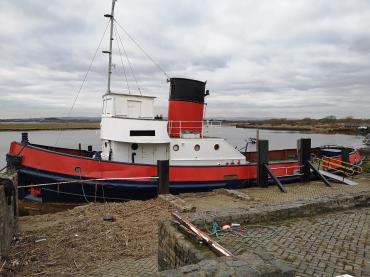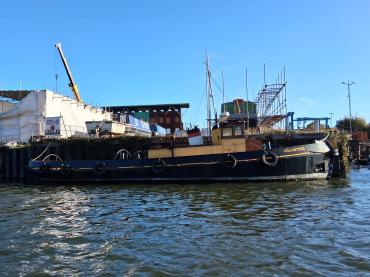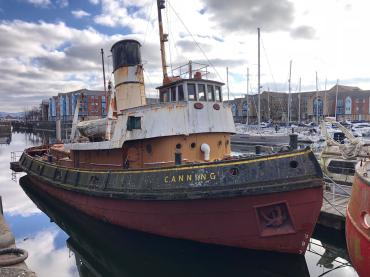


Previous names
- Hercules
Details
Construction
Dimensions
History
TID 164 was completed on 28 November 1945 by Pickergill and was in naval service at Port Edgar, on the Forth estuary, attached to HMS LOCHINVAR, the minesweeper base. In 1947, she was chartered by the Port of London Authority to work in the London Docks, returning the next year to the Firth of Forth to work at Rosyth Dockyard.
In December 1962, TID 164 was placed in reserve at Rosyth and, five years later, re-entered service there. In June 1974, she was sold to the Medway Maritime Museum for preservation and steamed to the Medway.
In 1975, she was renamed HERCULES to operate on towage for International Towing Ltd, a commercial venue of the Medway Maritime Trust. This work took her to London, Rye, the Clyde and the Caledonian Canal, and ended in 1978. She reverted to her original name and, whilst berthed at Chatham, sank at her moorings when a drain plug in the bottom of her hull broke.
Since 1999, the cabin has been refitted again and the boiler has been retubed. In 2003, central heating was installed, running pipes in cable trays to match the original wiring and hiding radiators, in an attempt to reduce condensation and prevent rust. A new fresh water tank was also installed next to the sanitary tank forward of the wheelhouse, made of wood and resin.
Work continued in 2004, this time in Rod Bryant's dry dock at Otterham Quay. All the valves, which were attached to the hull, were removed, grit blasted re-machined and new tops fabricated where necessary, new studs and nuts fitted and the insides coated with a modern anti-corrosive paint. The wood of the rubbing strake was removed, the damaged metal cut away and renewed, and the lower metal strake replaced by individual brackets for each bolt to prevent water retention. The 'new' wood is 150 year old pine, which has been treated. The hull was high-pressure water blasted and ultrasonic thickness tested. Where plates were thin, an area was cut away and patches welded flush into the hull (not doublers), and the whole area was finished with airless sprayed red oxide and gloss paint. The tug received its regular boiler and general surveys and was ready for steaming again.
In 2009, she again sank at her berth and was raised.
Since the formation of The Friends of TID 164 in 2010, work is ongoing to restore the vessel.
TID 164 was cared for at Chatham Historic Dockyard by volunteers of the TID 164 Preservation Trust, until December 2023 when work ceased. As of July 2024, TID 164 is under new ownership. In February 2025, TID 164 moved to her new home at Gillingham Pier.
Source: Paul Brown, Historic Ships The Survivors (Amberley, 2010). Updated: November 2015, Friends of TID 164. Updated: July 2024, TID 164 Preservation Trust on Facebook.
Significance
What is the vessel’s ability to demonstrate history in her physical fabric?
TID 164 is one of only five surviving examples of a standard type of tug built in large numbers during wartime. Between 1942 and 1946 182 were built by order of the Ministry of War Transport to a simplified design to allow the construction of prefabricated sections by inland steel fabricators. They utilised a hard chine design involving a sharp change in angle in the hull’s cross section. The eight sections, each weighing up to six tons, were transported and welded together at a shipyard.
TID 164 was one of 23 tugs assembled at the yard of William Pickersgill & Sons at Southwick, Sunderland. The boiler, engine and superstructure were all added after launching. She was completed on 28 November 1945. All TIDs were built with an open navigation platform, although many, including TID 164, later had enclosed wheelhouses fitted. All 182 TIDS were originally steam-powered; the first 90 were coal-fired, although later ones, including TID 164, were oil-fired. Many were subsequently converted to diesel; only three survive as steam-powered tugs.
TID 164 was powered by a 2-cylinder compound steam reciprocating engine, generating 220 ihp through a single boiler and driving a single screw. Her bunkers accommodated 8.6 tons of oil and she was able to maintain a speed of 8.5 knots. Her boiler was of the Scotch Return Tube type, having been built by D. Rowan & Co Ltd in Glasgow in 1945.
TID 164 is largely unchanged from her original design and build, although a cabin was fitted early on. Since 1999, the cabin has been refitted and the boiler has been retubed. In 2003, central heating was installed, and running pipes in cable trays were fitted to match the original wiring and hide radiators. A new freshwater tank was installed next to the sanitary tank forward of the wheelhouse, made of wood and resin.
In 2004 all valves attached to the hull were removed, grit blasted, re-machined and new tops fabricated where necessary. New studs and nuts were fitted and the insides coated with anti-corrosive paint. The wood of the rubbing strake was removed, the damaged metal cut away and renewed, and the lower metal strake replaced by individual brackets for each bolt. The hull was high-pressure water blasted and its thickness tested. Where plates were thin, patches were welded flush into the hull and the whole area finished with sprayed red oxide and gloss paint. TID 164 is subject to regular boiler and general surveys.
What are the vessel’s associational links for which there is no physical evidence?
On completion TID 164 entered naval service at Port Edgar, on the Forth estuary, attached to HMS LOCHINVAR, the minesweeper base. In 1947 she was chartered by the Port of London Authority to work in the London Docks, returning the following year to the Firth of Forth to work at Rosyth Dockyard. In December 1962 she was placed in reserve at Rosyth, re-entering service there five years later. In June 1974 she was sold to the Medway Maritime Museum for preservation.
Between 1975 and 1978 she operated commercially on towage duties under the name HERCULES for International Towing Ltd, a commercial venture of the Medway Maritime Trust. This work took her to London, Rye, the Clyde, and the Caledonian Canal. In 1978 she reverted to her original name and, whilst berthed at Chatham, sank at her moorings when a drain plug in the bottom of her hull broke. In 2009, she again sank at her berth and was raised.
Since the formation of The Friends of TID 164 in 2010, work has been ongoing to restore the vessel. However it is understood that the group have disbanded in late 2023.
TID 164 was recorded on the National Register of Historic Vessels in 1996 and is a member of the National Historic Fleet.
How does the vessel’s shape or form combine and contribute to her function?
TID 164 was built for the wartime Ministry of War Transport as a mass-produced tug designed for a wide range of duties for both government service and charter to commercial operators. Her design meant that she could be prefabricated off-site and transported to a shipyard for assembly. Her design also meant that the boiler, engine, and superstructure could be constructed off-site and added to the vessel after launching. This enabled the rapid construction of TIDs. During peak production, one tug was turned out every four and a half days.
Her powerful engine, her thick steel hull, and her basic superstructure enabled TID 164 to fulfil the wide range of duties she was called upon to perform. She was well-fitted for her intended purpose, and the nature of mass production meant that all features were extensively tried and tested. She required few modifications or adaptations during her working life.
TID 164 has now been in the hands of the Medway Maritime Museum and subsequent heritage bodies for nearly 50 years (since June 1974). She currently sits outdoors on a mudbank alongside Chatham Historic Dockyard exposed to all weathers. She was repainted prior to 2020.
Aesthetically, TID 164 is highly representative of her time, being one of a very large number in use during the war and beyond. She was built for practicality rather than aesthetic appearance. She illustrates an important part of the wartime naval story and is strategically located at a national naval museum. With her black hull, yellow superstructure, and tall yellow funnel she is an iconic symbol of British history during the Second World War.
Sources:
Paul Brown, Historic Ships: The Survivors (Amberley, 2010), 73-75.
Brouwer, Norman J, International Register of Historic Ships (Anthony Nelson, 1993), 128.
Steamboat Register: An illustrated Register of surviving steam vessels in the British Isles
(Steam Boat Association of Great Britain, 1994).
Key dates
-
1945
Built by W. Pickersgill & Sons of Sunderland for the Ministry of War Transport
-
1947
Chartered by the Port of London Authority
-
1948
Worked at Rosyth Dockyard
-
1962
Placed on reserve
-
1967
Re-entered service
-
1974
Sold to the Medway Maritime Museum for preservation
-
1975
Renamed HERCULES and employed on towage for International Towing Limited
-
1978
Reverted to her original name at Chatham
-
1999
Ongoing restoration work at Chatham
-
2009
Sunk at her moorings and raised
-
2012
Vessel selected for Avenue of Sail, Queen’s Diamond Jubilee Pageant on 3/6/2012, but did not attend
-
2010
Friends of TID 164 formed to restore her.
Grants
-
February 2025
A Sustainability Grant of £500 towards a survey was made from the Strategic Development Fund of National Historic Ships UK, supported by Winter & Co Marine Ltd
Sources
Brouwer, Norman J, International Register of Historic Ships, Anthony Nelson, Edition 2, 1993
Steamboat Register: An illustrated Register of surviving steam vessels in the British Isles, Steam Boat Association of Great Britain, Edition 6, May 1994
Classic Boat, June 1991
Classic Boat: 1,000 Boat Pageant - Steamers and Workboats, June 2012
Ships Monthly: Tugs of War, pp16-19, October 1998
Ships Monthly: Still in Steam - Steam Tug Brent, January 1997
Warship World: TIDs were a Temporary Measure, Spring 1986
Hall, Ron L, Steam Tug 'Brent' - leaflet, Hall, Ron L
Own this vessel?
If you are the owner of this vessel and would like to provide more details or updated information, please contact info@nationalhistoricships.org.uk
















